
The Fastnet Race is a biennial offshore yacht race organized by the Royal Ocean Racing Club (RORC) of the United Kingdom with the assistance of the Royal Yacht Squadron in Cowes and the City of Cherbourg in France.
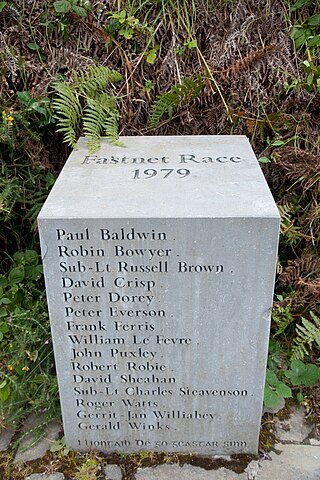
The 1979 Fastnet Race was the 28th Royal Ocean Racing Club's Fastnet Race, a yachting race held generally every two years since 1925 on a 605-nautical-mile course from Cowes direct to the Fastnet Rock and then to Plymouth via south of the Isles of Scilly. In 1979, it was the climax of the five-race Admiral's Cup competition, as it had been since 1957.

Padstow Lifeboat Station has been at Trevose Head west of Padstow, Cornwall, since 1967. Before that it was at Hawker's Cove on the Camel estuary between the town and the sea. The lifeboat station is run by the Royal National Lifeboat Institution (RNLI), and since 2006 has been the base for Tamar-class RNLB Spirit of Padstow.

Walmer Lifeboat Station is located on The Strand on Walmer promenade, in the county of Kent.

Wells-next-the-Sea Lifeboat Station is located at the end of Beach Road, about 1 mi (1.6 km) north of the town of Wells-next-the-Sea, on the north coast of the English county of Norfolk.

The Mumbles Lifeboat Station is at Mumbles Pier, located at the south-western corner of Swansea Bay, near the village of Mumbles, within the city and county of Swansea, in the historic county of Glamorgan, Wales.

Angle Lifeboat Station is located near the village of Angle, on the southern side of the entrance to the Milford Haven Waterway in Pembrokeshire, Wales.
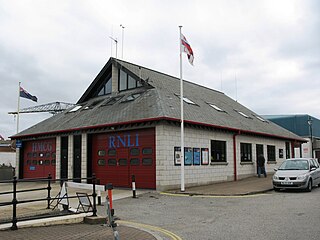
Falmouth Lifeboat Station is the base for Royal National Lifeboat Institution (RNLI) search and rescue operations at Falmouth, Cornwall in the United Kingdom. The first lifeboat was stationed in the town in 1867 and the present station was opened in 1993. It operates a Severn Class all-weather Lifeboat (ALB) and an Atlantic 85 inshore lifeboat (ILB).

Appledore Lifeboat Station is the base for Royal National Lifeboat Institution (RNLI) search and rescue operations at Appledore, Devon, England. The first lifeboat was stationed in the town in 1825 and the present station was opened in 2001. It operates a Tamar-class all-weather boat (ALB) and an Atlantic 85 B Class inshore lifeboat (ILB).
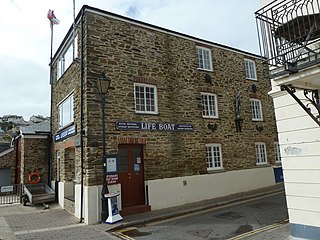
Salcombe Lifeboat Station is the base for Royal National Lifeboat Institution (RNLI) search and rescue operations at Salcombe, Devon in England. The first lifeboat was stationed in the town in 1869. The Salcombe Lifeboat has twice capsized, in 1916 with the loss of 13 lives, and in 1983 with no loss of life. Since 2008 the station has operated a Tamar-class all weather boat (ALB) and an Atlantic 85 inshore lifeboat (ILB).

Sennen Cove Lifeboat Station is the base for Royal National Lifeboat Institution (RNLI) search and rescue operations for the sea around Land's End, Cornwall in the United Kingdom. The first lifeboat was stationed at Sennen Cove in 1853. Since 2009 it has operated a Tamar-class all-weather boat (ALB) and a D-class (IB1) inshore lifeboat (ILB).

Cardigan Lifeboat Station is located at Poppit Sands, on the southern side of the River Teifi estuary in North Pembrokeshire, approximately 3 miles (4.8 km) north-west of the town of Cardigan, Wales.

Shoreham Harbour Lifeboat Station is a Royal National Lifeboat Institution (RNLI) station located in the town of Shoreham-by-Sea in the English county of West Sussex.
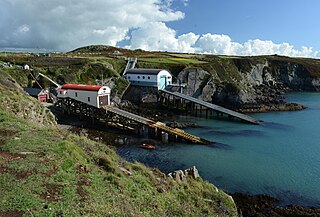
St Davids Lifeboat Station is a Royal National Lifeboat Institution (RNLI) station. It was opened in 1869 and to date has been involved in saving over 360 lives at sea in more than 420 launches. The station operates both an all-weather (ALB) and an inshore (ILB) lifeboat.

Eastbourne Lifeboat Station is a Royal National Lifeboat Institution (RNLI) lifeboat station in the town of Eastbourne in East Sussex. Founded two years before the RNLI was established, the station has operated continuously since 1822, and its lifeboats have been responsible for saving over 700 lives.

Clovelly Lifeboat Station, serving the North Devon village of Clovelly and surrounding coastal waters, is run by the Royal National Lifeboat Institution (RNLI). It was established in 1870. The station is flanked by Appledore to the northeast and Bude to the southwest.
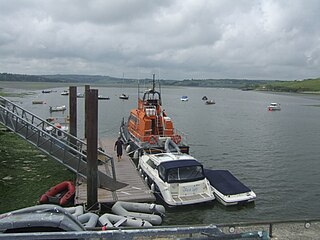
Courtmacsherry Harbour Lifeboat Station is located on Sea Road, in the village of Courtmacsherry, County Cork, on the southern shore of the Argideen River estuary, approximately 45 kilometres (28 mi) south west of Cork, on the south coast of Ireland.
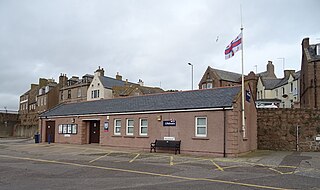
Peterhead Lifeboat Station is located at West Pier, in the harbour town of Peterhead, in the NE corner of Aberdeenshire, Scotland.

Ballycotton Lifeboat Station is the base for Royal National Lifeboat Institution (RNLI) lifeboat at Ballycotton in County Cork, Ireland. It opened in 1858 and continues to operate today. Its most notable rescue was the crew of the Daunt Rock lightship in 1936 which kept the crew at sea for the best part of three days.
Kilmore Quay Lifeboat Station is the base for Royal National Lifeboat Institution (RNLI) lifeboat at Kilmore Quay in County Wexford, Ireland. It was known as just Kilmore Lifeboat Station until 1986.





















